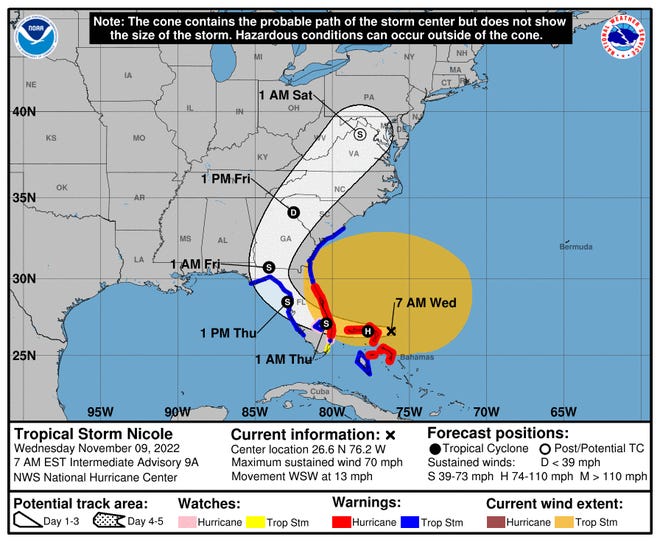
Tropical Storm Nicole made landfall over the northwestern Bahamas late Wednesday morning with an expected arrival along Florida’s east coast as a Category 1 hurricane Wednesday night.
Nicole arrived ashore over Great Abaco Island with maximum winds of 70 mph, according to the National Hurricane Center.
As of 4 p.m. Wednesday, the hurricane center said Nicole was 135 miles east of West Palm Beach. A hurricane warning was in effect early Wednesday for the east coast of Florida.
"Early tomorrow morning, we still expect it to intensify into a hurricane," AccuWeather hurricane expert Dan Kottlowski told USA TODAY. "Right now it's very close to that, it’s only 4 mph away from becoming declared a hurricane.”
Projections put landfall along the Treasure Coast late Wednesday, but the hurricane center warned residents to not focus on the exact track of Nicole because it remains a large storm.
After making U.S. landfall, Nicole's center is forecast to move across central and northern Florida into southern Georgia on Thursday and Thursday night, then into the Carolinas on Friday.
Here's what we know.
Where is Tropical Storm Nicole now?
Here is the latest data on Tropical Storm Nicole from the National Hurricane Center's 4 p.m. EST advisory.
- Location: 135 miles east of West Palm Beach
- Maximum sustained winds: 70 mph
- Movement: west at 13 mph
- Pressure: 985 millibars
- When next advisory will be released: 7 p.m. EST
Nicole is now a large tropical storm. Tropical-storm-force winds extend up to 485 miles, especially to the north of the center. Early Wednesday, a National Ocean Service station at the Lake Worth Pier reported sustained winds of 44 mph and a wind gust of 55 mph.

Nicole's center will approach the east coast of Florida within the hurricane warning area tonight. Some strengthening was expected, and Nicole was forecast to become a hurricane near the northwestern Bahamas and remain a hurricane when it reaches Florida tonight.
Nicole was expected to weaken while moving across Florida and the southeastern United States on Thursday through Friday and become a post-tropical cyclone by Friday night over the mid-Atlantic states.
Now it's serious: Jim Cantore spotted in Daytona Beach area as Tropical Storm Nicole approaches
What damage could Nicole do?
Tropical storm conditions in the northwestern Bahamas and portions of Florida’s east coast Wednesday were expected to spread to Georgia and South Carolina later Wednesday. The National Hurricane Center also forecasted hurricane conditions in Florida by Wednesday night or Thursday morning.
Nicole could trigger dangerous storm surge up to 5 feet in areas along the Florida and Georgia coasts, and water levels could reach up to 6 feet in the Bahamas, according to the hurricane center.
Forecasters predicted “a few tornadoes” Wednesday night through Thursday across eastern Florida, southeast Georgia and southern South Carolina.
Rainfall will be a key concern, according to Kottlowski. Nicole is expected to drench the northwestern Bahamas and parts of Florida with between 3 to 5 inches of rain before moving north.
“There’s a possibility of a lot of flash flooding in the western Carolinas up to perhaps the mountains of Virginia and into Pennsylvania,” Kottlowski said.
Storm forces evacuations in Florida
Residents in several Florida counties – Flagler, Palm Beach, Martin and Volusia – were ordered to evacuate several barrier islands, low-lying areas and mobile homes. Volusia, home to Daytona Beach, imposed a curfew and warned that intercoastal bridges used by evacuees would close when winds reach 39 mph.
Nicole is a rare November storm
Nicole is a rare storm: Only one hurricane on record has made landfall after Nov. 4 in the continental U.S. That was Hurricane Kate on Nov. 21, 1985, which hit at Category 2 intensity near Mexico Beach, Florida, said Colorado State University hurricane researcher Phil Klotzbach.
NASA, Artemis I prep for Nicole
Kennedy Space Center and Cape Canaveral Space Force Station are preparing the massive moon-bound Artemis I rocket ahead of Nicole bearing down on Florida.
The rocket will ride out the storm at Kennedy Space Center’s pad 39B. Officials opted out of the multi-day task of rolling the multibillion-dollar rocket to the Vehicle Assembly Building some four miles away. The building is rated to handle winds up to 85 mph, and a Category 1 storm’s winds are between 74 and 95 mph.
"The rocket is designed to withstand heavy rains at the launch pad and the spacecraft hatches have been secured to prevent water intrusion," NASA said in a statement.
NASA confirmed Tuesday it would delay the Space Launch System rocket's liftoff to no earlier than 1:04 a.m. EST Wednesday, Nov. 16, due to Nicole.
Nicole path: Track the storm here
AFTER HURRICANE IAN:New criticism for the 'cone of uncertainty'
Contributing: Ashley R. Williams, Doyle Rice USA TODAY
Source link








